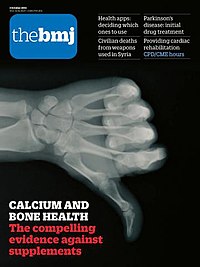Provincial Medical and Surgical Journal
 |
|
|
Former names
|
Provincial Medical and Surgical Journal, British Medical Journal, BMJ |
|---|---|
|
Abbreviated title (ISO 4)
|
BMJ |
| Discipline | Medicine |
| Language | English |
| Edited by | Fiona Godlee |
| Publication details | |
| Publisher |
BMJ (United Kingdom)
|
|
Publication history
|
1840–present |
| Frequency | Weekly |
| Immediate, research articles only | |
| License | Creative Commons Attribution Non-commercial License |
| 17.445 | |
| Indexing | |
| ISSN |
0959-8138 (print) 1756-1833 (web) |
| LCCN | 97640199 |
| CODEN | DXRA5 |
| OCLC no. | 32595642 |
| JSTOR | 09598138 |
| Links | |
The BMJ is a weekly peer-reviewed medical journal. It is one of the world's oldest general medical journals. Originally called the British Medical Journal, the title was officially shortened to BMJ in 1988, and then changed to The BMJ in 2014. The journal is published by the global knowledge provider BMJ, a wholly owned subsidiary of the British Medical Association. The editor in chief of The BMJ is Fiona Godlee, who was appointed in February 2005.
In the 2016 Journal Citation Reports, The BMJ's impact factor was 19.697 in 2015, ranking it fourth among general medical journals.
The journal began publishing on 3 October 1840 as the Provincial Medical and Surgical Journal and quickly attracted the attention of physicians around the world through its publication of high-impact original research articles and unique case reports. The BMJ's first editors were P. Hennis Green, lecturer on the diseases of children at the Hunterian School of Medicine, who also was its founder and Robert Streeten of Worcester, a member of the PMSA council.
The first issue of the British Medical Journal was 16 pages long and contained three simple woodcut illustrations. The longest items were the editors' introductory editorial and a report of the Provincial Medical and Surgical Association's Eastern Branch. Other pages included a condensed version of Henry Warburton's medical reform bill, book reviews, clinical papers, and case notes. There were 2 1⁄2 columns of advertisements. Inclusive of stamp duty it cost 7d, a price which remained until 1844. In their main article, Green and Streeten noted that they had "received as many advertisements (in proportion to the quantity of letter press) for our first number, as the most popular Medical Journal, (The Lancet) after seventeen years of existence."
...
Wikipedia
